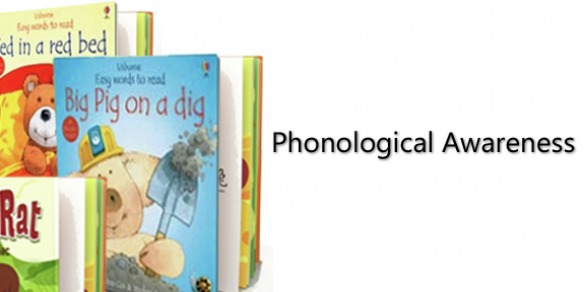conscious attention to the sounds of spoken language
Phonological Awareness Includes:
- Phonemes - the smallest unit of sound
- Syllables - the unit of pronunciation consisting of a vowel alone or a vowel with a consonant
- Onset - the consonant sound of a syllable that comes before the vowel
- Rime - the vowel sound and everything that comes after it
Why is it Important?
- Considered the most powerful predictor of later reading achievement
- A child’s phonological skills in first grade predict how well a child will read in third grade (and beyond)
Block, Meghan. (2010). Phonological Awareness and Letter Sound Knowledge
[PowerPoint Slides]. Retrieved from University of Michigan State.
[PowerPoint Slides]. Retrieved from University of Michigan State.
Typical Order of Acquisition of Phonological Awareness Skills
1. Recognize and Generate Rhyming Words
- Give a child a word and the child can generate rhyming words (known as word families)
- May include “real words” and nonsense words
- Examples include providing the word cat and the child comes up with mat, sat, and dat
- Child recognizes words that rhymes
- Either hearing them or in print
- An example would be the child hearing the words hear and fear in text and telling you that they rhyme
- Combine syllables to say words
- /mag/ + /net/ = magnet
- /blan/ + /ket/ = blanket
- Segment spoken words into syllables
- hockey = /hock/ + /ey/
- Bubble = /bub/ + /ble/
- Using the onset (the initial consonant sound(s) prior to the vowel) and the rime (the vowel and everything after it) the child can blend the sounds together to say the word
- /m/ and /ice/ to form mice
- /g/ and /oal/ to form goal
- /p/ and /uck/ to form puck
- Alliteration: producing words in a sentence that start with the same sound
- Example: Tucker took ten toucans to town Tuesday.
- Rhyme: producing words that end with the same sound
- Example: Fat cat sat
- Example: Fat cat sat
- What happens if we take away the beginning sound of a word?
- Example: What word do I have if I take away the /c/ in cat?
- What happens if we take away the ending sound of a word?
- Example: What word do I have if I take away the /s/ in cats?
Block, Meghan. (2010). Phonological Awareness and Letter Sound Knowledge
[PowerPoint Slides]. Retrieved from University of Michigan State.
[PowerPoint Slides]. Retrieved from University of Michigan State.
Order of Acquisition
- Syllables/beats
- Rhyming
- Individual phonemes/sounds
- Recognition
- Generation
- Beginnings
- Endings
- Middles
- Blendings
- Segmenting
- Ability to move sounds around to create new words
Shedd, Meagen. (2009). Retrieved from University of Michigan State.
Vocabulary Related to Phonological Awareness:
- Breve -The symbol placed over a vowel to show that it’s a short sound.
- Example: ĕ
- Cicrumflex - Symbol placed over vowel graphemes to indicate pronunciation.
- Example: â
- Closed and Open Syllable - A syllable has a vowel and one or more consonant and there is only one vowel in each syllable. Open syllables and with vowel sounds. Closed syllables end with consonant sounds.
- Consonants - A sound represented by any letter of the English alphabet except a,e,i,o,u. Consonants are sounds made by closing or restricting the breath channel.
- Digraph - Two letters that stand for a single phoneme/sound
- Dipthong - When one vowel sound moves into another while being the same syllable
- Grapheme - What you actually write to represent a sound
- Macron - Symbol placed over vowel to show it is pronounced as a long sound.
- Example: Ā
- Onset - Consonant that comes before the vowel in the syllable
- Phoneme - Smallest sound unit of a language (There are 44 in American English alone)
- Phonemic Awareness - The ability to see that words are made up of phonemes
- Phonetics - The study of human speech sounds
- Phonics - Methods to teach beginning reader. Teachers teach phonics not phonetics
- Phonogram - Similar to a rime except that it’s the graphic representation. Vowel grapheme and ending consonant grapheme.
- Rime - Part of the syllable that include the vowel sound and any consonants that come after it
- Schwa Sound - The most common vowel sound in English and can be represented by any vowel letter. It makes an UH sound.
- Syllable - A unit of pronunciation consisting of a vowel along or a vowel with one or more consonants. There can be only one vowel phoneme (sound) in each syllable.
- Umlaut - Symbol placed over vowel to indicate pronunciation. Example: ü
- Vowel - a,e,i,o,u and sometimes w and y. Vowels are made without closing or restricting the breath channel
Ways to Help Students Develop Phonological Awareness:
- Songs
- Songs with rhyming words
- Songs with rhyming blanks
- Example: Down by the Bay
- Songs with phonemic manipulation
- Example: The Name Game, Apples and Bananas, Old MacDonald, Willoughby Wallaby Woo
- Books, Poems, Tongue Twisters
- Nursery rhymes and rhyming poems
- Books with rhyming
- Books with alliteration
- Books with phonemic manipulation
- Tongue twisters
- Word games
- “Count the Beats!”
- Sort things or friends by the number of syllables or beats
- “Going on Vacation”
- Taking turns saying what they’re going to take on vacation, where there’s a rule like it must start with /b/ (“the buh sound”) or must have a certain number of beats r the like
- “Who Gets Up?”
- Determine who gets up with some rule like everyone whose name starts with /j/
- “Guess what I’m Saying”
- Saying words in partially or entirely segmented form and children guess what the word is. m/a/p = map
- Stretching Words
- Also referred to as “turtle talk,” “whale talk,” or “gummy words”
- Use when writing in front of children
- Example: “mmoooommm” when spelling Mom
- It can also be used as a form of play
- Example: “jooooooolllllllllllaaaaaaaaa” for Julia
Helping Students to Gain the Ability to. . .
Separate words into syllables or beats
Recognize and generate words that rhyme
Recognize and generate words that start or end with the same sound
Blend sounds into words
Segment words into sounds
Move sounds around to create new words
Separate words into syllables or beats
Recognize and generate words that rhyme
Recognize and generate words that start or end with the same sound
Blend sounds into words
Segment words into sounds
Move sounds around to create new words
Will Eventually Help Students to. . .
Break down a word into parts to spell or decode/read it. For example, to spell the word chapter, break it into chap and ter
Use known words to read new words. For example, to use catch to help them read batch
Learn to associate particular sounds with particular letters. For example, knowing that Peter starts with pPeter recognize that purple also starts with p
“Sound out” words. For example, after saying a sound for each letter in the word nap (/n/ /a/ /p/), putting those sounds together to say nap
Spell words. For example, to hear the found sounds in the clap (/c/ /l/ /a/ /p/), so they can spell it
Use known words to figure out new words. For example, to use corn to help them decode the word pork may help.
Break down a word into parts to spell or decode/read it. For example, to spell the word chapter, break it into chap and ter
Use known words to read new words. For example, to use catch to help them read batch
Learn to associate particular sounds with particular letters. For example, knowing that Peter starts with pPeter recognize that purple also starts with p
“Sound out” words. For example, after saying a sound for each letter in the word nap (/n/ /a/ /p/), putting those sounds together to say nap
Spell words. For example, to hear the found sounds in the clap (/c/ /l/ /a/ /p/), so they can spell it
Use known words to figure out new words. For example, to use corn to help them decode the word pork may help.
Block, Meghan. (2010). Phonological Awareness and Letter Sound Knowledge
[PowerPoint Slides]. Retrieved from University of Michigan State.





